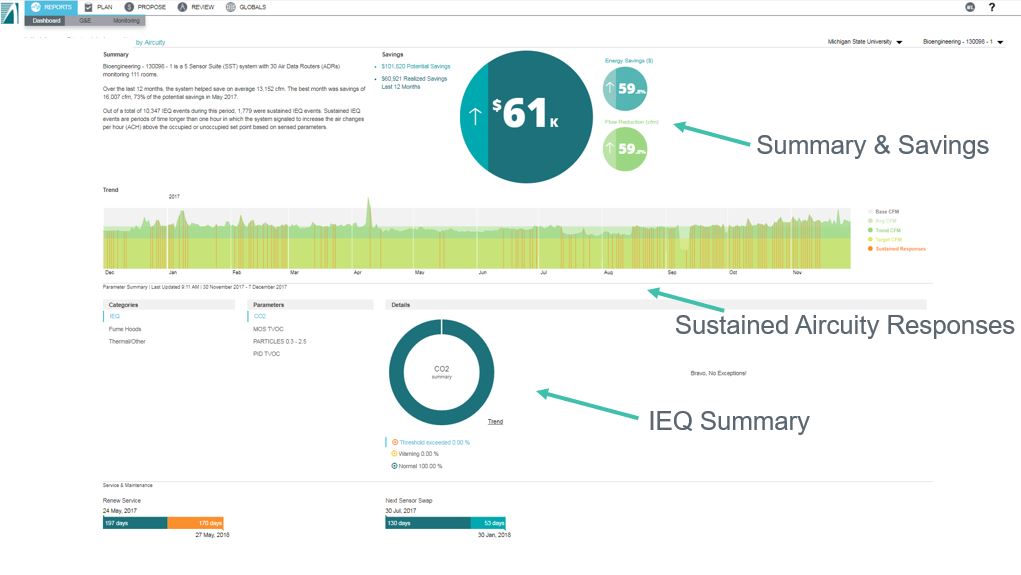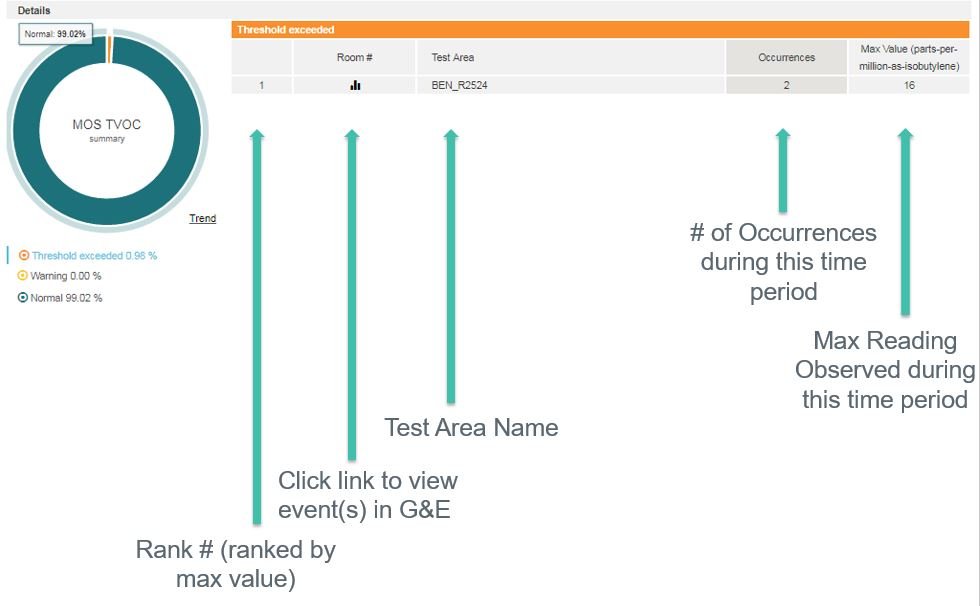New solutions offer ways to proactively prioritise laboratory safety and system performance, says building ventilation solutions specialist Aircuity.
There is no replacement for safe lab practices and following the guidance of Environmental Health & Safety (EHS) professionals. So, is there a role for new technology and advancement in the EHS profession? And can this technology assist in making labs more intelligent and provide better worker protection?
Intelligent airflow management platforms employing demand control ventilation (DCV) technology provide the EHS teams at research centres with the ability to gather data about air quality within laboratories and to proactively identify, and in many cases rectify, safety concerns.
These new insights offer a great opportunity for near real-time training of desired practices and event response and greater understanding of what is happening across a large footprint of research space. Simultaneously, the integrated solution offers airflow system response and increased occupant protection by raising ventilation rates when needed.
This article will describe these intelligent platforms and the benefits they offer to EHS professionals, while looking to discuss typical concerns and common misperceptions.

Insights offer understanding of what is happening across a large footprint of research space.
Laboratory airflow demands are one of many EHS professional concerns
By necessity, the task of the EHS team at any research university or other large research institution is broad and varied. From training researchers on safe lab practices, responding to incidents, networking with outside groups like fire marshals and facilities departments, to doing safety outreach and now deploying “green lab” outreach initiatives; the task of the EHS team is to mitigate risk and keep everyone working within the laboratories safe.
Lab dilution ventilation is just one of the components that goes into protecting occupants, and it should be made clear that there is no ventilation that can rectify truly unsafe lab practices.
Traditionally, the practice was to maximize air change rates (ACH). With ACH of 12+ per hour, the idea was that any potential hazardous chemicals are highly diluted, thus keeping the occupants safe. There are three problems with this practice. First, following a spill, the higher ACH flowing over a spill actually causes an increased evaporation and subsequent higher exposure. Next, in some cases, these higher ACH rates, which are extremely expensive, are turned down substantially at night causing unsafe conditions for those initially entering or returning into a lab when unknown events have occurred and/or when entering during ‘unoccupied hours’. Lastly, this practice causes enormous energy expense, using more air than needed for the vast majority of the time.
The idea with a demand based approach is to solve all of these challenges simultaneously. Ventilation is optimised, providing more air when needed and avoiding over ventilating when it is not. Just as important is the benefit of insight and intelligence to see what is happening, where and when across a large footprint.
Demand control ventilation poses a workable solution for EHS airflow challenges
DCV systems seek to address the deficiencies inherent in fixed rate ventilation systems by balancing safety with energy efficiency. Air exchange rates can now be tied to real-time data so ventilation can be variable and based on current conditions in the lab versus arbitrarily static – either wasting energy or providing less air then desired when and where it’s needed.
Also, by providing intelligent insight into the operations of the lab, principal investigators (PIs), researchers, and now EHS professionals can all have a real-time window into lab practices. In the past, this only happened when reacting to an event, at which point it is too late.
Benefits of DCV in action
Demand based platforms are not to be considered a part of a lab’s threat detection system, as they do not detect and remove airborne agents that are immediately toxic. Dilution ventilation is not a replacement for safe lab practices! However, continuous data collection and reporting identifies the protection provided in the form of increased ventilation during events and opportunities to improve safe lab practices through interpretation of events and behaviours.
With DCV, EHS personnel can measure how many events are occurring, where and when they happen, as well as frequency, duration, and indications of cause. This data can then be accessed by PIs and other researchers as well as the EHS team in order to identify training or maintenance needs.
Given this, intelligent demand based control is protecting occupants through air change rate variation while also saving substantial energy. Additionally, in rare instances when a fume hood may malfunction or a lab occupant may accidentally create a fugitive emission from a fume hood, the monitoring capability can capture this data. The system automatically increases air change rates and logs the event as part of the data reporting.

DCV dashboard helps to identify a CO2 leak. The system responded to the leak by increasing ventilation rates and EH&S was able to save time and money in repairing it.
Real life examples
A university EHS professional had just logged into a DCV dashboard when an incident jumped out at him – more than 2,000 parts per million (ppm) of carbon dioxide (CO2) in a room for about 24 hours. He immediately went to the room and investigated the cause. After a bit of exploration, he discovered a faulty CO2 gas piping connection on piece of equipment. The piping was fixed and the leak went away.
By using the analytics to identify the leak as CO2, the university was able to save money associated with performing additional leak testing on all of their gas piping systems. In addition, the data showed that the DCV system responded and increased ventilation rates as designed.
In another example, at a laboratory in a leading research university in Philadelphia, the DCV system flagged a particular day of the week and time of day when contamination levels outside of the normal range were regularly occurring. The university’s EHS personnel were able to use that data to identify a particular lab technician who was employing unsafe practices, retrain that technician, and greatly reduce the risk of exposure to the contaminants over time.
Deploying demand based control intelligently
The US Department of Energy has adopted and is now promoting a Smart Lab concept pioneered by University of California Irvine. They have published a decision tree to properly and intelligently deploy demand based control across over 1,500 lab spaces on their campus. This decision tree found that approximately 86% of all spaces qualified for demand based control.
This means that certain spaces may require much higher base level ACH rates – it is an owner’s decision to determine whether monitoring of IEQ should be done instead of demand based control. In short, it remains critical to understand where hazardous materials exist and to train and promote safe lab practices when working under hoods with hazardous chemicals.
Technology gives EHS personnel a set of eyes in each lab at all times
Intelligent demand based control technology provides EHS personnel with the ability to have a set of “eyes” in each lab at all times. This helps them determine whether existing safety practices are working, provides data for retraining when necessary, and preserves occupant safety by optimizing lab dilution air as needed.
In doing so, the platform enables EHS teams to take a proactive approach to laboratory airflow safety. They can use the data to reduce the burden of daily tasks and allow EHS staff to focus on higher value organisational change.
At the same time, this smart platform significantly decreases energy usage through the elimination of over-ventilation. Incorporating an intelligent system into a research centre’s air management is not about reducing air, but instead about maintaining the health and safety of all laboratory occupants and adding a layer of insight that was previously not available. Remember, not all labs are suited for DCV technology and it should be intelligently deployed with careful coordination between the facilities team, EHS and experienced third-party professionals when needed.
When deployed appropriately, organisations receive the dual benefit of substantial savings and new insight and intelligence for their EHS and PI staffs. This reduces risk, generates savings, and leverages advances that have been made with these new approaches. Certainly the successes with many leading research institutions should be testament to others considering adopting and deploying demand based control – less money, more air when needed, and insightful data seems like a winning formula.
What makes us susceptible to burnout?
In this episode of the Safety & Health Podcast, ‘Burnout, stress and being human’, Heather Beach is joined by Stacy Thomson to discuss burnout, perfectionism and how to deal with burnout as an individual, as management and as an organisation.
We provide an insight on how to tackle burnout and why mental health is such a taboo subject, particularly in the workplace.



